What to do if the leaves of eggplant seedlings turn yellow?
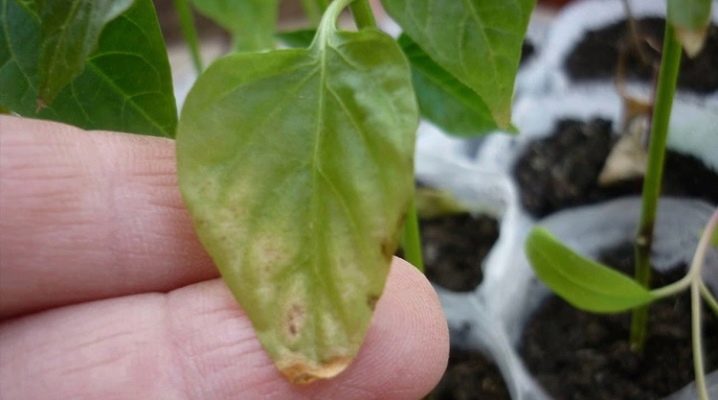
Eggplant is a rather capricious and picky culture, it requires scrupulous adherence to the rules of agricultural technology. Often, gardeners are faced with yellowing of seedlings. Let us dwell in more detail on the causes of this problem and methods of plant protection.

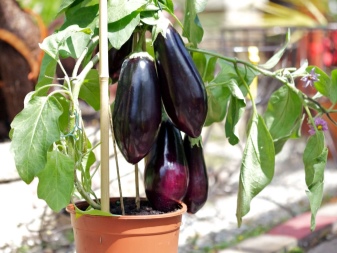
Bad conditions
Unfavorable growing conditions are one of the most common factors in changing the shade of eggplant leaf plates.
- Excess ultraviolet radiation. If you notice that the seedlings have begun to turn yellow in the apical part, and the lower one is green, most likely, too much bright sunlight falls on the immature seedlings. Excess ultraviolet light causes the breakdown of chlorophyll, which is needed for the full growth and development of each plant. As a result, the leaf turns yellow in whole or in part, in the latter case, multiple specks or large spots are formed on it. The upper leaves, directed towards the sunny side of the window, if the eggplant seedlings are grown on a windowsill, or a greenhouse, will help to confirm the cause of the disease. They turn yellow and deformed. To save the plant, you need to move the container to a dark place. In the case when it is not possible to do this, during the hours of the active sun, you need to create a small shelter using tulle or other translucent fabric.
- Poor substrate quality. Peat soil with high acidity is unsuitable for growing eggplant seedlings. It is also not recommended to use garden land where tomatoes and other nightshades were grown before. For blue ones, the soil from legumes, zucchini or cabbage will be optimal. For growing seedlings, specialized soil for eggplants or tomatoes is suitable. It must be properly prepared - spilled with a solution of potassium permanganate, baked in the oven or steamed in a water bath. To improve the structure, it will be useful to add vermiculite, perlite, coconut substrate or river sand to the soil mixture. This measure will increase its moisture and air permeability.
- Lack of light. When the lighting regime is violated, a change in the color of the leaves is often observed. Under unfavorable conditions, the course of photosynthesis is disrupted; as a result, green chlorophyll is replaced by yellowish xanthophyll. During a short daylight hours, seedlings need to do additional highlighting. If the young plant lacks light, the bush will be pale, elongated and weakened.
- Violation of the temperature regime. At low temperatures, rotting of the root system begins. In this case, the ground part of the seedlings receives less nutrients and moisture, turns yellow and soon dies.
But excessive heating is also dangerous for the plant. The optimal temperature for the blue ones will be 16-20 degrees.
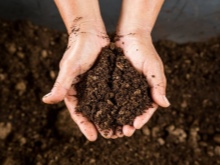
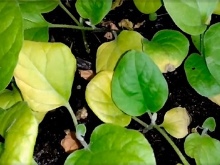
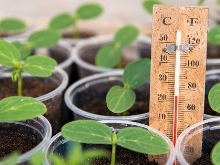
Improper care
Care errors also lead to wilting of the plant. Excess or deficiency of beneficial micronutrients. Young eggplant seedlings are extremely demanding on the balance of micro and macro elements. It reacts especially sharply to the content of potassium, nitrogen and phosphorus.
- If you notice that the edges of the leaves have turned yellow, and the leaf plates themselves have begun to curl like a boat, the seedlings need to be fed with potassium.
- If the leaf plate brightens and becomes reddish, the eggplants are faced with a phosphorus deficiency. By the way, the reason for this phenomenon may not be a lack of fertilizing, but a too low soil temperature.For example, when the seedlings are grown on a windowsill and experience constant drafts, the soil will be cold. In this state, eggplants do not assimilate phosphorus - the summer resident feeds his bushes, and the plant still experiences starvation.
- If the leaves turn pale, turn yellow and hang lifelessly, they need nitrogen.
- If the leaf plates become pale yellow, almost lemon, but the veins remain deep green, then the seedlings are faced with chlorosis. It indicates an excess of nitrogen, any violation of the calcium content (both excess and deficiency), as well as a lack of iron.


To avoid adverse consequences, you do not need to wait for the eggplant seedlings to tell about an unbalanced diet with their withering appearance. Every two weeks, young seedlings should be fertilized with specialized mineral complexes. Modern fertilizer manufacturers offer formulations for plants that are highly sensitive to the nutrient value of the soil in the very early stages of the growing season. Improper watering. The yellowing of the apical leaves of eggplants begins in case of non-observance of the optimal humidity regime. With an excess of water, the color change is accompanied by the appearance of wet earthy clumps near the woven roots. The earth turns sour and creates an environment for the reproduction of pathogenic microflora - this leads to a change in the level of acidity.
Sometimes on the walls of containers where young seedlings are grown, you can see a greenish bloom. It becomes the result of fungal activity. If these symptoms occur, it is necessary to completely replace the soil mixture, treat the containers with a fungicidal preparation, and be sure to make drainage holes. After transplanting, the seedlings will need a reduced irrigation regime for some time. Lack of watering also leads to wilting of the plant. In the early stages, the leaves become lethargic and change their color to yellow. If you do not take urgent measures, the blue ones stop developing and dry out. The leaves may turn yellow after transplanting the bushes into open ground. This is due to the fact that any plant undergoes severe stress during transplantation.
To facilitate adaptation, it is best to replant a young plant with an earthy clod. With this technique, the roots remain closed and therefore intact. With proper care, within 5-7 days, not a single trace of stress will remain.
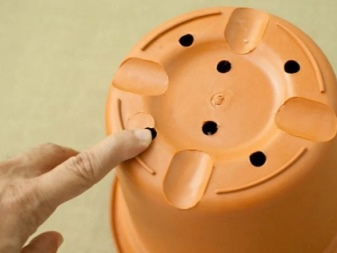

Treatment of diseases
Among the reasons that can lead to yellowing of the leaf plates of young eggplants, one can single out the defeat of infectious diseases. Most often, the plant attacks fusarium. One of its first symptoms is the yellowing of the leaves, while the veins of the yellowed foliage become very light. When affected by Fusarium, the blue ones weaken, their development slows down, then stops altogether, and the seedlings die.
To prevent the development of this infection, it is necessary to carry out pre-sowing disinfection of seed material, soil and container. At the first signs of fusarium, it is necessary to remove all affected seedlings from the containers, replace the soil mixture, and disinfect the containers. The bushes themselves are sprayed with fungicidal preparations, the greatest effect is given by the compositions "Strekar" and "Benazol". Throughout the growing season, seedlings should be treated with the biological preparation "Trichodermin" every two weeks.
Another disease is verticillosis. This fungal infection causes a rapid yellowing of the leaf blades on the seedlings. Soon, the leaves become covered with large spots, begin to curl in a spiral, dry up and fall off. It is very difficult to treat this ailment, therefore, special attention should be paid to pre-plant prevention of the spread of a fungal disease.If the disease still struck a young plant, it is necessary to remove and destroy the diseased seedlings as soon as possible, and transplant the remaining seedlings into a new container with new soil. At the final stage, the seedlings and the substrate are sprayed with fungicides.
When a tobacco mosaic appears, the leaves first change their shade to light, then dark spots appear on them. The affected leaf plate resembles a mosaic. In the absence of proper treatment, the leaves are deformed and fall off. If the leaf plates of eggplant seedlings brighten, carefully examine the entire bush. If you notice that the stem has begun to turn black near the base, it means that the culture has encountered black rot. The infection quickly descends to the roots; it is no longer possible to save the plant at this stage.
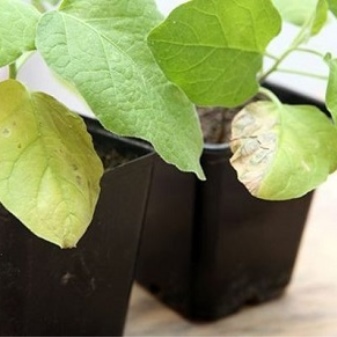
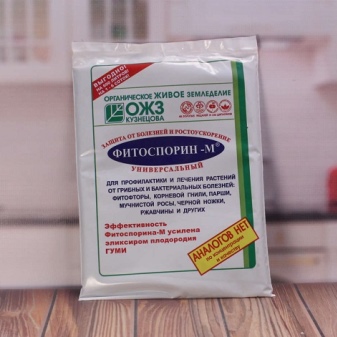
To avoid the appearance of an ailment, you should correctly maintain the distance between individual bushes of seedlings, comply with the requirements for watering and temperature conditions. When signs of disease appear, the affected bushes must be destroyed, and the earth must be shed with Fitosporin solution.
Any fungal diseases have the most unfavorable effect on a young plant and in most cases lead to wilting. Therefore, special attention should be paid to preventive measures. To avoid infection of eggplant seedlings, and to prevent yellowing of the leaves, which then begin to curl and fall off, you must follow the standard requirements.
- Eggplants cannot stand the drying out of the earth, so the soil must be regularly moistened.
- Don't overfeed your eggplants with fertilizers.
- To prevent the leaves from turning yellow, the seedlings should be disinfected with a solution of potassium permanganate before planting.
- The soil in which the eggplants grow must be breathable, it is recommended to loosen it as often as possible.
- When moving seedlings to the street, you need to choose a site in such a way that it is well lit and does not stagnate water.
- Transplanting is best done with an earthen ball, so the risk of injury to the plant can be minimized.
- When planting in each hole with seedlings, it is advisable to add "Trichodermin".
- If you notice diseased plants, you need to remove them from the ground as soon as possible so that the infection does not spread to healthy bushes, and treat the rest with fungicides.
- Watering should be done in the morning or in the evening after sunset, always at the root.
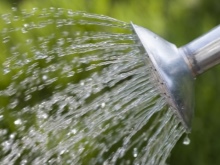
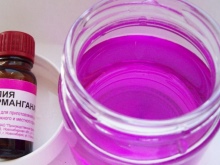














The comment was sent successfully.